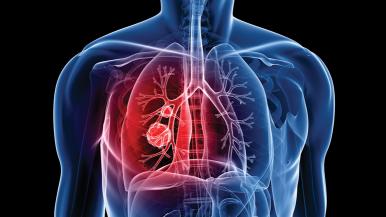Cancer care is constantly evolving. And nowhere is that more true than with lung cancer.
“In just the last few years, lung cancer care has evolved considerably,” says Gaurav Marwaha, MD, radiation oncologist at RUSH MD Anderson Cancer Center. “The types of treatment options and treatment combinations that existed just a few years ago are now almost completely changed for the better.”
The most promising change of all is that the outlook for surviving lung cancer has significantly improved.
Finding lung cancer earlier
Like most cancers, when you detect lung cancer early treatment is more likely to be successful. In recent years, lung cancer screening has played an important role in detecting lung cancer earlier in people who have the highest risk for it.
Lung cancer screening is a simple, noninvasive annual test that includes a low-dose CT scan of the lungs. Lung cancer screening may be available if you meet all three of the following screening criteria:
- You're between the ages of age 50 and 80.
- You're currently smoking or have quit within the last 15 years. (If you're currently smoking, we can help you quit.).
- You have a "20 pack-year" history of smoking, calculated by multiplying the number of packs smoked per day times the number of years you've smoked. For example: One pack a day for 20 years OR two packs a day for 10 years.
Though she has a long history of smoking, Gina never thought she'd get lung cancer. Then, a screening revealed an early-stage tumor. Read more.
“Through our comprehensive lung cancer screening program, we’re detecting far more early-stage lung cancers,” says Michael Liptay, MD, thoracic surgeon at RUSH MD Anderson. “When we find lung cancer at an early stage, there is a greater chance that we’ll be able to treat it with a minimally invasive surgery. Many patients who have had early-stage lung cancer are now beating it thanks to early detection and screening.”
New, effective treatments
Lung cancer causes about 25% of all cancer deaths each year, and it is the leading cause of cancer death among both men and women. However, an article cites a decrease in lung cancer mortality over the past few years.
That decrease can be attributed to both early detection with lung cancer screening and new, effective therapies that have only recently become available, according to RUSH MD Anderson medical oncologist Mary Jo Fidler, MD.
“In the last few years, we’ve had several new FDA approvals for lung cancer treatments and combinations," Fidler says. “It’s been a fast and dramatic change, and it’s great for the patients to have so many effective treatment options.”
These new options have helped improve outcomes for both early- and late-stage cancers. “It used to be that if you had a stage 4 lung cancer (the most advanced cancer), there were very limited options, and survival was often less than one year,” Marwaha says. “Now, we can offer a variety of treatments for these patients, including targeted therapies, immunotherapies, focused radiation therapies, minimally invasive surgeries — and sometimes a combination of these treatments. In doing so, we are often able to put their disease into remission for many years.”
Immunotherapies, in particular, have played an important role in better outcomes, helping many patients go into remission for several years — which was not possible until very recently. “Cancer can put the brakes on your own immune system in fighting cancer,” Fidler says. “Immunotherapy works by releasing the brakes and allows your body to attack the cancer.”
Liptay notes: “Immunotherapy has revolutionized outcomes for lung cancer patients with advanced disease. In the past, chemotherapy only worked for a small fraction of these patients, but with immunotherapy we’ve seen dramatic and long-standing results for these patients.”
In addition to medications and targeted treatments, advances in technology continue to both improve outcomes and reduce the side effects of cancer treatment.
“From a radiation standpoint, we’re able to tailor our treatments to be more precise and safer,” Marwaha says. “With new technology and improved visualization, we can better treat the cancer while avoiding healthy tissue that we want to protect. For our patients, that means great outcomes and fewer, or even no, side effects from treatment.”
Finally, surgical treatments also continue to help patients survive and thrive after a lung cancer diagnosis. “We offer a number of innovative techniques to diagnosis and treat lung cancer in a minimally invasive way,” says Christopher Seder, MD, thoracic surgeon at RUSH MD Anderson. “That includes video-assisted thoracoscopic surgery (VATS), robotic surgery and interventional techniques that use computer navigation to biopsy small lung lesions or lymph nodes with great precision. And, by doing these procedures in a minimally invasive way, it allows patients to have a better overall experience, along with better outcomes, less pain and shorter hospital stays.”
A chronic condition
“With all of these improvements in treatments, we’ve been able to treat lung cancer more as a chronic disease for many of our patients,” Seder says. “We have patients who are five or 10 years out from their diagnosis of lung cancer.”
To do this, a multidisciplinary team of specialists follows each patient, quickly addressing any complications or recurrence (if the cancer returns).
“The combination of improvements in treatment options, reduction in side effects and very close follow-up for all of these patients has been the recipe for success for our patients,” Marwaha says. “With close follow-up, we’re able to catch new areas of concern quickly and address them if need be. It’s very similar to how we treat and manage care for people who have diabetes or high blood pressure. We can optimize therapies and help patients get back on track. This allows our patients to continue living their lives, often with a very good quality of life.”
Leading the way with research
Advances in lung cancer care are continuing to evolve at a rapid pace, thanks to clinical trials and research.
“We have many clinical trials and procedures that we can offer our patients that may not be generally available at other centers,” Fidler says. “We’ve worked hard to bring clinical trials to our patients at most stages of lung cancer.”
While research continues to revolve around improvements in therapies, it also focuses on helping protect patients’ quality of life.
“We’ve made so many advancements in just the last few years within lung cancer research,” Marwaha says. “The priority for research now is finding ways to move the field forward — not only by expanding novel therapies and access to these therapies for our patients, but also determining how can we do all of those things and make sure people who have lung cancer are still living with a high quality of life. We want our patients to continue to live their day-to-day lives, doing what they enjoy.”
Overall, the future for lung cancer care looks brighter.
“I’ve been taking care of lung cancer patients for 30 years,” Liptay says. “In that time, it has gone from being a very difficult disease to treat to now having so many options for our patients — and I’m very optimistic for the future.”




